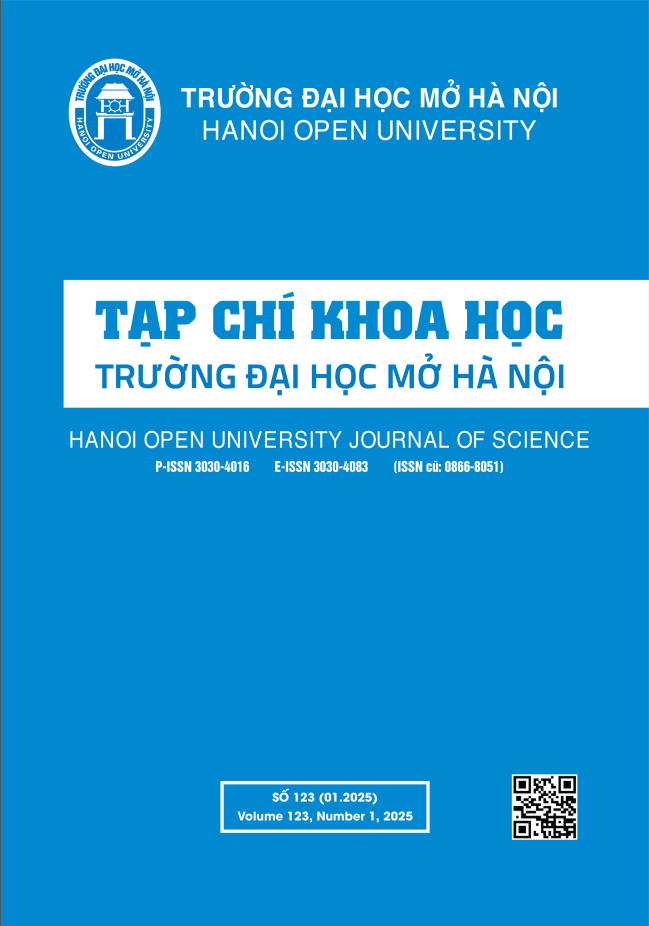ĐÁNH GIÁ VIỆC SỬ DỤNG PHẢN HỒI LỖI VIẾT TỰ ĐỘNG CÔNG CỤ GRAMMARLY ĐỂ CẢI THIỆN THÀNH TÍCH VIẾT LUẬN CỦA SINH VIÊN CHUYÊN NGÀNH TIẾNG ANH
DOI:
https://doi.org/10.59266/houjs.2025.525Từ khóa:
Grammarly, Phản hồi, Phản hồi lỗi viết tự độngTóm tắt
Việc sử dụng phản hồi lỗi viết tự động đã trở nên phổ biến trong việc dạy và học tiếng Anh. Những giáo viên dạy tiếng Anh, đặc biệt là kỹ năng viết luận ngày càng quan tâm tới công nghệ này vì nó có thể giảm bớt khối lượng công việc cho họ. Rất nhiều nghiên cứu trước giờ đều tập trung vào tính hiệu quả và thái độ của người học về công nghệ này, còn quan điểm của giáo viên về việc bản thân họ cũng như người học sử dụng phản hồi lỗi viết tự động (PHLVTĐ) thì ít được quan tâm. Vì vậy, nghiên cứu này đã áp dụng phương pháp hỗn hợp, trước tiên là để xem xét nhận thức của năm giảng viên về việc sử dụng PHLVTĐ, cụ thể là công cụ Grammarly Premium, để sửa bài luận của sinh viên; thứ hai là để xem xét liệu phản hồi do Grammarly tạo ra có hiệu quả hơn phản hồi do giảng viên cung cấp hay không. Ba mươi học sinh trong nhóm thử nghiệm (TN) đã áp dụng Grammarly để chỉnh sửa và xem lại bài luận của mình, trong khi ba mươi học sinh khác trong nhóm đối chứng (ĐC) nhận được phản hồi sửa lỗi từ giảng viên. Việc sử dụng kiểm định t mẫu ghép đôi cho thấy sinh viên trong ĐC có kết quả tốt hơn sinh viên của TN ở bài kiểm tra sau. Ngoài ra, kết quả từ các cuộc phỏng vấn vừa tích cực và tiêu cực đối với việc sử dụng các công cụ. Các đề nghị về cách tích hợp các công cụ này vào lớp học được thảo luận.
Tài liệu tham khảo
[1]. Braun, V., & Clarke, V. (2012). Thematic analysis. In H. Cooper (Ed.), APA handbook of research methods in psychology, 2, 57–71. American Psychological Association.
[2]. Dembsey, J. M. (2017). Closing the Grammarly® Gaps: A Study of Claims and Feedback from an Online Grammar Program. The Writing Center Journal, 36(1), 63–100. http://www.jstor.org/ stable/44252638
[3]. Dizon, G. & Gayed, J, M. (2021). Examining the impact of Grammarly on the quality of mobile L2 writing. The JALT CALL Journal, 17(2), 74–92.
[4]. Dodigovic, M., & Tovmasyan, A. (2021). Automated writing evaluation: the accuracy of Grammarly’s feedback on form. International Journal of TESOL Studies 3 (2), 71–87.
[5]. Farrokhnia, M., Banihashem, S. K., Noroozi, O., & Wals, A. (2023). A SWOT analysis of ChatGPT: Implications for educational practice and research. Innovations in Education and Teaching International, 1–15. https://doi.org/10.1080/14703297.2023.2195846
[6]. Fitria, T.N. (2021). Grammarly as AI- powered English Writing Assistant: Students’ Alternative for Writing English. The Journal of English Language and Literature, 5, 65-78.
[7]. Ghufron, M. A. (2019). Exploring an automated feedback program ‘Grammarly’ and teacher corrective feedback in EFL writing assessment: modern vs. traditional assessment. Proceedings of the 3rd English Language and Literature International Conference, ELLiC, Semarang, Indonesia.
[8]. Hoang, G. T. L., & Kunnan, A. J. (2016). Automated essay evaluation for English language learners: A case study of MY Access. Language Assessment Quarterly, 13(4), 359–376. https://doi. org/10.1080/15434303.2016.1230121
[9]. Hyland, K., and Hyland, F. (2019). Feedback in Second Language Writing: Contexts and Issues. Cambridge, UK: Cambridge University Press. doi: 10.1017/9781108635547
[10]. Iskender, A. (2023). Holy or unholy? Interview with open AI’s ChatGPT. European Journal of Tourism Research, 34, 3414. https://doi.org/10.54055/ejtr. v34i.3169
[11]. Koltovskaia, S. (2023). Postsecondary L2 writing teachers’ use and perceptions of Grammarly as a complement to their feedback. ReCALL. 35(3), 290-304. doi:10.1017/S0958344022000179
[12]. Liao, H. C. (2015). Using automated writing evaluation to reduce grammar errors in writing. ELT Journal, 70(3), 308–319. https://doi.org/10.1093/elt/ ccv058
[13]. Li, J., Link, S., & Hegelheimer, V. (2015). Rethinking the role of automated writing evaluation (AWE) feedback in ESL writing instruction. Journal of Second Language Writing, 27, 1–18. http://dx.doi.org/10.1016/j. jslw.2014.10.004
[14]. Mao, S., and Crosthwaite, P. (2019). Investigating written corrective feedback:(Mis) alignment of teachers’ beliefs and practice. Journal of Second Language Writing, 45, 46–60. https:// doi.org/10.1016/j.jslw.2019.05.004.
[15]. O’Neill, R., & Russell, A. M. (2019). Grammarly: Help or hindrance? Academic learning advisors’ perceptions of an online grammar checker. Journal of Academic Language and Learning, 13(1), 88-107.
[16]. Ranalli, J. (2021). L2 student engagement with automated feedback on writing: Potential for learning and issues of trust. Journal of Second Language Writing, 52, 100816.
[17]. Silverman, D. (2016). Qualitative research (4thed.). Sage Publications.
[18]. Zhang, L.J., & Cheng, X. (2021). Examining the effects of comprehensive written corrective feedback on L2 EAP students’ linguistic performance: A mixed-methods study. Journal of English for Academic Purposes, 54, 101043.
[19]. Zheng, Y., & Yu, S. (2018). Student engagement with teacher written corrective feedback in EFL writing: a case study of Chinese lower-proficiency students. Assessing Writing, 37, pp. 13–24.
